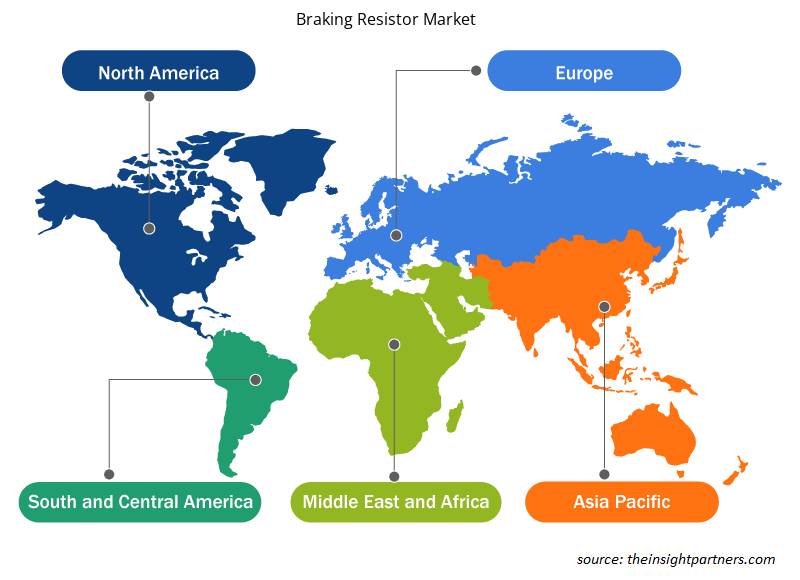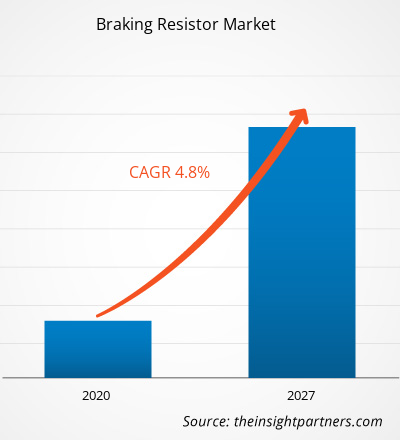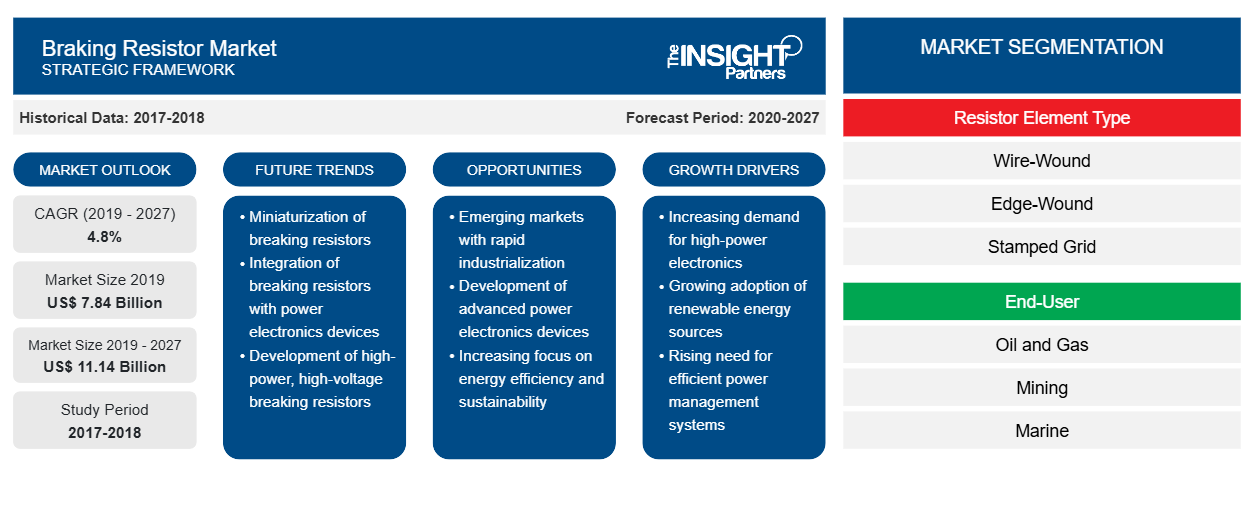Der Markt für Bremswiderstände hatte im Jahr 2019 einen Wert von 7.838,1 Millionen US-Dollar und soll bis 2027 einen Wert von 11.141,9 Millionen US-Dollar erreichen; von 2020 bis 2027 dürfte er mit einer durchschnittlichen jährlichen Wachstumsrate von 4,8 % wachsen.
Ein Bremswiderstand oder dynamische Bremswiderstände (DBRs) arbeiten als Wechselstrom-Frequenzumrichter (VFDs), um die im Motor erzeugte Energie mithilfe des zum Stoppen des Motors angewendeten Bremsmoments zu zerlegen. Dieser Widerstand wird im Gleichstrombus eingesetzt, der bei Bremsbedingungen eine Spannung von etwa 800 Volt benötigt. Dynamische Bremswiderstände werden in Gleichstromantriebssystemen und Wechselrichtern verwendet und auch als elektrische Antriebsmotoren in Schienenfahrzeugen als Generatoren zum Abbremsen der Lokomotive eingesetzt. Dieser dynamische Widerstand wird auch als „Rheostat“ bezeichnet, da er elektrische Energie erzeugt, die regenerativ ist, wenn die Energie in die Versorgungsleitung zurückgeführt und in Bremsgitterwiderständen als Wärme abgeführt wird. Dieser Widerstand erzeugt ein Bremsmoment und absorbiert die zusätzliche Energie, die beim Stoppen der Elektromotoren erzeugt wird. Diese Widerstände werden in Antriebssystemen mit variabler Geschwindigkeit wie Kränen, Aufzügen und Zügen eingesetzt. Aufgrund der zunehmenden Urbanisierung und des industriellen Wachstums ist der Energieverbrauch um ein Vielfaches gestiegen. Um den steigenden Strombedarf zu decken, wird daher die Entwicklung von Unter- und innerstaatlichen Übertragungsnetzen vorangetrieben. Der steigende Energie- und Strombedarf aufgrund steigender Haushaltseinkommen und wachsender Fertigungs- und Schwerindustrie beflügelt den Markt für Bremswiderstände. Erneuerbare Energien spielen eine wichtige Rolle bei der Bereitstellung von Zugang zu Elektrizität. Laut der Internationalen Energieagentur (IEA) wird der Strombedarf weltweit bis 2040 voraussichtlich um 2,1 % pro Jahr steigen. Der Strombedarf in Südostasien gehört zu den höchsten der Welt; er bietet Potenzial für den Sektor der erneuerbaren Energien. All diese Faktoren werden voraussichtlich das Wachstum des Bremswiderstandsmarktes im Prognosezeitraum ankurbeln.
Europa dominierte 2019 den Markt für Bremswiderstände und wird seine Dominanz im Prognosezeitraum voraussichtlich beibehalten. Die Technologieinvestitionen in Europa stiegen 2019 trotz der wirtschaftlichen Abschwächung aufgrund der Spannungen zwischen Großbritannien und der Europäischen Union (EU). Automobilhersteller verfügen über 304 Fahrzeugmontagewerke und Produktionsstätten in 27 Ländern in ganz Europa. Im Jahr 2019 wurde die Produktion von 4.371.499 Einheiten von Nutzfahrzeugen und Personenkraftwagen gemeldet. Die wachsende Produktion von Nutzfahrzeugen und Personenkraftwagen lässt die Nachfrage nach der Integration von Bremswiderständen steigen.
Passen Sie diesen Bericht Ihren Anforderungen an
Sie erhalten kostenlos individuelle Anpassungen an jedem Bericht, einschließlich Teilen dieses Berichts oder einer Analyse auf Länderebene, eines Excel-Datenpakets sowie tolle Angebote und Rabatte für Start-ups und Universitäten.
- Holen Sie sich die wichtigsten Markttrends aus diesem Bericht.Dieses KOSTENLOSE Beispiel umfasst eine Datenanalyse von Markttrends bis hin zu Schätzungen und Prognosen.
Auswirkungen der COVID-19-Pandemie auf den Markt für Bremswiderstände
Das Auftreten und die schnelle Verbreitung des neuartigen Coronavirus (COVID-19) hat zahlreiche Länder, darunter Industrie- und Entwicklungsländer, lahmgelegt. Der kontinuierliche Anstieg der Zahl infizierter Patienten bedroht mehrere Branchen auf der ganzen Welt. Stand Dezember 2020 sind die USA, Indien, Brasilien, Russland und Frankreich einige der am schlimmsten betroffenen Länder in Bezug auf bestätigte COVID-19-Fälle und gemeldete Todesfälle. Der Ausbruch wirkt sich aufgrund von Lockdowns, Reiseverboten und Betriebsschließungen negativ auf die Wirtschaft und Industrie in verschiedenen Ländern aus. Darüber hinaus nimmt die Nachfrage nach Bremswiderständen stark ab, da die wichtigsten Abnehmerländer für Bremswiderstände ihre Investitionen in diese Komponenten reduzieren und einen beträchtlichen Prozentsatz ihres Budgets für die Bekämpfung des COVID-19-Ausbruchs verwenden. Die vorübergehende Schließung von Produktionsanlagen behindert auch das Wachstum des Marktes für Bremswiderstände. Die anhaltende Verbreitung von COVID-19 wird das Wachstum der Akteure auf dem Markt für Bremswiderstände in den kommenden Jahren bremsen.
Markteinblicke
Steigende Vorliebe für Elektrofahrzeuge steigert die Nachfrage nach Bremswiderständen
Die großen Akteure im Automobilsektor investieren in die Produktion von Elektrofahrzeugen. In jüngster Zeit wurden bemerkenswerte Kooperationen zwischen Automobilherstellern und Technologieunternehmen zur Entwicklung technologisch fortschrittlicher Elektrofahrzeuge eingegangen. So arbeitete Fiat Chrysler im Dezember 2019 mit dem französischen Automobilhersteller PSA Group zusammen, um sich auf die Entwicklung von Elektrofahrzeugen zu konzentrieren. Darüber hinaus sind das zunehmende Bewusstsein für die steigenden Treibhausgasemissionen und die negativen Auswirkungen konventioneller Fahrzeuge die Hauptfaktoren, die wichtige Akteure dazu ermutigen, in Elektrofahrzeuge zu investieren. Mehrere große Unternehmen freuen sich darauf, in Startups zu investieren, die ihnen in Zukunft bei der gemeinsamen Entwicklung von Produkten helfen können. So investierte Hyundai, ein Automobilhersteller mit Hauptsitz in Seoul, Südkorea, im März 2019 gemeinsam mit seiner Tochtergesellschaft Kia 300 Millionen US-Dollar in Ola Electric, um Mobilitätslösungen und Autos speziell für die indische Bevölkerung herzustellen. Die Elektrofahrzeuge nutzen regeneratives Bremsen, das die beim Bremsen verlorene Energie zurückgewinnt und an die Batterie zurücksendet. Alternativ ist es vorteilhaft, einen Bremswiderstand zu verwenden, um die überschüssige Energie abzuführen. Diese Widerstände sind im Falle eines elektrischen Defekts nützlich und reduzieren die Wartungskosten durch den geringeren Verschleiß des Reibungsbremssystems. Darüber hinaus wird die beim dynamischen Bremsen im Widerstand abgegebene Energie auch zum Heizen des Anhängers oder der Kabine des Fahrzeugs verwendet. Dadurch wird der Bedarf an elektrischer Heizung verringert, die eine zusätzliche Belastung der Batterie darstellt.
Markteinblicke basierend auf Widerstandselementtypen
Basierend auf dem Widerstandselementtyp ist der globale Markt für Bremswiderstände in drahtgewickelte, hochkantgewickelte, gestanzte Gitterwiderstände und andere unterteilt. Drahtgewickelte Widerstände bieten erhebliche Vorteile wie hervorragende Leistungsableitung, Stoßfestigkeit und stabilen Widerstand. Dieser Widerstand wird in verschiedenen Anwendungen eingesetzt, im Wesentlichen als Leistungswiderstand, bei dem größere Leistungsmengen abgeführt werden. Der drahtgewickelte Widerstand besteht aus einem Widerstandsdraht, der um ein nichtleitendes Material gewickelt ist. Im Allgemeinen ist der Widerstandsdraht isoliert, damit benachbarte Drähte nicht kurzgeschlossen werden.
Endbenutzerbasierte Markteinblicke
Basierend auf dem Endverbraucher ist der Markt für Bremswiderstände in Öl und Gas, Bergbau, Schifffahrt, Automobil und Eisenbahn, Energie und andere unterteilt. Die steigende Nachfrage nach Personenkraftwagen und Nutzfahrzeugen, vor allem in Entwicklungsländern, verstärkt den Bedarf an Bremswiderständen zur Geschwindigkeitsregelung und Nutzung der überschüssigen Energiemenge. Im Jahr 2014 meldete China die Produktion von 24 Millionen Fahrzeugen, diese Zahl soll bis 2030 bzw. 2050 auf rund 364 bzw. 607 Millionen steigen. Weltweit sind mehrere Hersteller an der Entwicklung verschiedener Fahrzeugmodelle beteiligt, die die Integration von Bremswiderständen erfordern. Daher beschleunigt die zunehmende Integration von Bremswiderständen im Automobil- und Eisenbahnmarkt das Wachstum des Marktes für Bremswiderstände.
Regionale Einblicke in den Bremswiderstandsmarkt
Die regionalen Trends und Faktoren, die den Bremswiderstandsmarkt während des Prognosezeitraums beeinflussen, wurden von den Analysten von Insight Partners ausführlich erläutert. In diesem Abschnitt werden auch die Marktsegmente und die Geografie des Bremswiderstandsmarkts in Nordamerika, Europa, im asiatisch-pazifischen Raum, im Nahen Osten und Afrika sowie in Süd- und Mittelamerika erörtert.

- Holen Sie sich die regionalspezifischen Daten für den Bremswiderstandsmarkt
Umfang des Marktberichts über Bremswiderstände
| Berichtsattribut | Details |
|---|---|
| Marktgröße im Jahr 2019 | 7,84 Milliarden US-Dollar |
| Marktgröße bis 2027 | 11,14 Milliarden US-Dollar |
| Globale CAGR (2019 - 2027) | 4,8 % |
| Historische Daten | 2017-2018 |
| Prognosezeitraum | 2020–2027 |
| Abgedeckte Segmente | Nach Widerstandselementtyp
|
| Abgedeckte Regionen und Länder | Nordamerika
|
| Marktführer und wichtige Unternehmensprofile |
|
Dichte der Marktteilnehmer für Bremswiderstände: Auswirkungen auf die Geschäftsdynamik verstehen
Der Markt für Bremswiderstände wächst rasant, angetrieben durch die steigende Nachfrage der Endnutzer aufgrund von Faktoren wie sich entwickelnden Verbraucherpräferenzen, technologischen Fortschritten und einem größeren Bewusstsein für die Vorteile des Produkts. Mit steigender Nachfrage erweitern Unternehmen ihr Angebot, entwickeln Innovationen, um die Bedürfnisse der Verbraucher zu erfüllen, und nutzen neue Trends, was das Marktwachstum weiter ankurbelt.
Die Marktteilnehmerdichte bezieht sich auf die Verteilung der Firmen oder Unternehmen, die in einem bestimmten Markt oder einer bestimmten Branche tätig sind. Sie gibt an, wie viele Wettbewerber (Marktteilnehmer) in einem bestimmten Marktraum im Verhältnis zu seiner Größe oder seinem gesamten Marktwert präsent sind.
Die wichtigsten auf dem Bremswiderstandsmarkt tätigen Unternehmen sind:
- ABB Ltd.
- Bonitron
- Captech Pty Ltd.
- CRESSALL RESISTORS LTD.
- REO AG
Haftungsausschluss : Die oben aufgeführten Unternehmen sind nicht in einer bestimmten Reihenfolge aufgeführt.

- Überblick über die wichtigsten Akteure auf dem Bremswiderstandsmarkt
Produktentwicklung ist die häufigste Strategie von Unternehmen, um ihr Produktportfolio zu erweitern. ABB Ltd., Vishay, Schneider Electric, Kanthal und Yashkawa gehören zu den wichtigsten Akteuren, die Strategien zur Erweiterung des Kundenstamms und zur Erlangung bedeutender Anteile am globalen Markt für Bremswiderstände umsetzen, was ihnen wiederum ermöglicht, ihren Markennamen zu behaupten. Einige der jüngsten wichtigen Entwicklungen sind:
- Die regenerative Einheit R1000 der Yaskawa Electric Corporation vermeidet 2019 Energieverschwendung. Stattdessen wird sie an die Stromquelle zurückgespeist, wo sie von anderen Lasten genutzt werden könnte. Die regenerative Einheit R1000 ist eine sicherere Lösung für die Regeneration als das offene Heizelement, das in dynamischen Bremswiderständen verwendet wird.
- Im Jahr 2018 stellte Vishay Intertechnology, Inc. auf der IEEE PES T&D-Konferenz und -Ausstellung 2018 seine neuesten Widerstände für Energiesysteme in den Bereichen Öl und Gas, Industrie, Traktion und erneuerbare Energien vor.
Bremswiderstände-Marktsegmentierung:
Nach Widerstandselementtyp
- Drahtgewickelt
- Randgewickelt
- Geprägtes Gitter
- Sonstiges
Nach Endbenutzer
- Öl und Gas
- Bergbau
- Marine
- Automobil und Eisenbahn
- Energie
- Sonstiges
Firmenprofile
- ABB Ltd.
- Bonitron
- Captech Pty Ltd.
- CRESSALL RESISTORS LTD.
- REO AG
- Sandvik AB(Kanthal)
- Schneider Electric
- Toshiba International Corporation
- Vishay Intertechnology, Inc.
- Yaskawa Electric Corporation
- Historische Analyse (2 Jahre), Basisjahr, Prognose (7 Jahre) mit CAGR
- PEST- und SWOT-Analyse
- Marktgröße Wert/Volumen – Global, Regional, Land
- Branchen- und Wettbewerbslandschaft
- Excel-Datensatz
Aktuelle Berichte
Erfahrungsberichte
Grund zum Kauf
- Fundierte Entscheidungsfindung
- Marktdynamik verstehen
- Wettbewerbsanalyse
- Kundeneinblicke
- Marktprognosen
- Risikominimierung
- Strategische Planung
- Investitionsbegründung
- Identifizierung neuer Märkte
- Verbesserung von Marketingstrategien
- Steigerung der Betriebseffizienz
- Anpassung an regulatorische Trends























 Kostenlose Probe anfordern für - Markt für Bremswiderstände
Kostenlose Probe anfordern für - Markt für Bremswiderstände